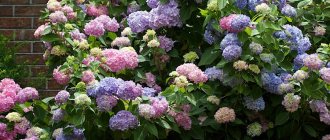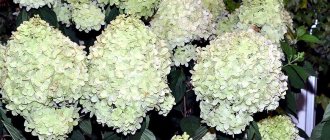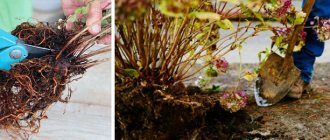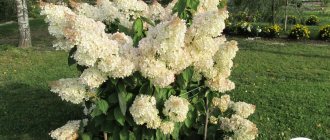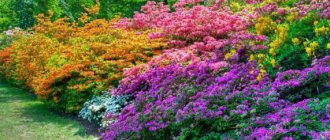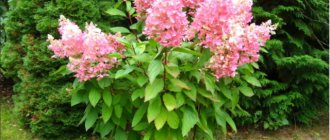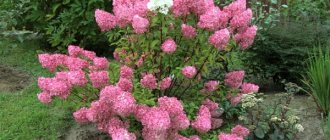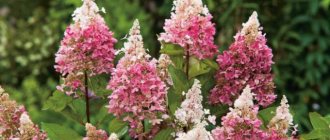General characteristics of large-leaved hydrangeas. Hydrangea Endless Summer
Photo of large leaf hydrangea
Absolutely any variety of hydrangea is a perennial shrub that overwinters in open space and gives a beautiful appearance during the flowering period throughout the summer. But differences between different types of hydrangeas still exist, in form and color. But their main difference from each other is on which shoots they bloom. Due to this, there are differences in their care. There are several varieties of hydrangea:
- Chereshkova. It looks like a weaving vine that wraps around vertical supports. It does not grow as a shrub, compared to other species.
- Paniculata. Has the ability to bloom on new branches grown in the current season. The inflorescences are white and pyramidal in shape. That is why in the autumn they prune it, quite briefly, leaving it to survive the winter period with only the roots of the plant being insulated.
- Tree-like. It is endowed with similar properties as the previous species, although it differs from it in the form and shade of the inflorescence. Has the ability to change color from white to green during one season.
- Large leaf. It is distinguished by rather bright, round-shaped inflorescences. It may bloom on last year's shoots. These varieties do not need heavy pruning. In the autumn, it is necessary to cover not only the root system, but also the branches, having previously bent them towards the soil. Because buds are subsequently formed on these branches, from which, accordingly, after removing the cover in the spring, flowers will form. It is imperative to protect the kidney from freezing. Because otherwise there will be no flowers, even though new shoots will grow.
Among large-leaf hydrangeas, the Endless Summer variety has gained particular love and popularity. It differs primarily in that flowers form on absolutely all shoots, whether new or last year’s. This can only mean that with high-quality care for the plant, it will produce lush and abundant color throughout the entire season, from the very beginning of summer until late autumn. This variety has another name - Endless Summer.
general information
Hydrangea Endless Summer deserves its name for its unique ability to bloom twice in one season. A similar “mutation” was bred by breeders and is considered the most successful among other varieties.
Interesting! This variety has one peculiarity - the shades of flowering depend on the acidity level of the soil.
Also, the large-leaved hydrangea Endless Summer is characterized by increased resistance even to severe frosts. However, the most amazing feature is that it is able to bloom first in June and then again 5 weeks later. As a result, the flowering process is repeated until mid-autumn.
Hydrangea Eternal Summer
Description of the variety
Endless summer hydrangea was bred by plant breeders in the United States in the 1980s. Hydrangea deserved increased attention during the period of severe frosts, when many plants froze in the states. Flower lovers noticed that in early spring only this plant managed to bloom. Subsequently, a new variety of this hydrangea was bred - a tall shrub with spherical large inflorescences in different shades - from light blue to pink.
- The flower reaches two meters in height and up to a meter in width.
- This variety is characterized by strong matte dark green foliage, which is framed by jagged edges.
- The hydrangea bush grows as a flexible but strong shoot.
- The shoots in the first years of life are dark green in color, but as they grow they become darker and gradually become woodier.
- Hydrangea has a round and compact shape.
- During flowering, massive and bright inflorescences appear, which reach 15 cm in diameter.
- The color depends on the acidity level of the soil in which the plant grows: an alkaline environment promotes the formation of pink inflorescences, acidic soil leads to the appearance of blue flowers.
This is interesting! Based on the Eternal Summer hydrangea, breeders have developed several new varieties. Among them, the snow-white hydrangea Summer Love deserves special attention.
Large-leaved hydrangea Endless summer: description of the variety
Hydrangea Endless Summer: photo
An important feature of the large-leaved hydrangea Endless Summer is to produce color more than once during the summer period. Of course, this is not a natural feature of hydrangea, but a successful fruit of the work of the scientists who developed it. The garden hydrangea Endless Summer begins to bloom for the first time at the beginning of summer, and the next flowering occurs in the middle of the summer period and continues until the onset of winter cold.
Thanks to this fact, this hydrangea is a favorite plant of our gardeners. An important circumstance of such love and fame among gardeners is that this hydrangea is capable of changing the shade of its flowers. This happens due to the specific composition of the growing soil, which farmers have easily learned to change for their own purposes.
Plus, to all that has been said, this variety does not require enormous and labor-intensive care. He will feel great even with normal care.
Appearance and features
The perennial plant is native to East Asia: Japan and China. Other names among professionals are hydrangia and macrophila. Broadleaf hydrangea is also called garden hydrangea.
The height of shrub forms ranges from 0.4 to 1.5 meters. Stems are erect, not bearing fruit. Wide large leaves, inflorescences (15-25 centimeters in diameter) of various colors - this is the appearance of hydrangea. Flowering is observed from July to September-October.
It grows in different soils, changing the color of the flowers from white, pink, to dark red and blue. To change the color, they resort to various tricks: they water it with special dyes, alum and vitriol, bury rusty nails under the bush, and add peat.
Planting hydrangea Endless Summer
Photo of hydrangea variety Endless Summer
First of all, before planting, take care of choosing the right site for it. It should be with enough sun and no drafts. After this you should:
- Dig up the place chosen for growing this shrub quite well, removing all the weeds growing there from such an area.
- Add organic fertilizer to the soil, such as compost, humus, turf, peat.
- Prepare a hole for the plant. The size is such that the root system of the seedling can easily fit there, without any kind of twisting or bending.
- Place a layer of drainage at the bottom of the hole, which is very important for good growing. Small pebbles can be used as drainage; they will prevent water from stagnating.
- The hole is watered, since it is extremely important to plant the plant in moist soil.
- Lower the seedling into the hole, carefully spreading the root system of the young bush. Sprinkle it with nutritious soil, compacting it a little. Water the planted seedling and mulch the soil on top.
- In the first few weeks after planting, keep an eye on the plant and soil. It should not dry out, so irrigate if necessary. Laying mulch will help retain some of the moisture in the soil.
Diseases and pests
Hydrangea Early Sensation - variety description, planting and care
Hydrangea Eternal Summer is quite resistant to powdery mildew, but is sensitive to water used for irrigation. Due to the high alkali content, the shrub may undergo chlorosis. Therefore, it is better to use rainwater for the plant.
If the bush is affected by downy mildew, special preparations that contain copper are used.
Spider mites are another important problem and the main pest of hydrangeas. Chemical spraying is used to get rid of harmful insects.
Spider mite
Basic care rules
Hydrangea Endless Summer: photo
For the garden hydrangea of the Endless Summer series, as for any perfect plant, timely care is required. Moreover, care measures with their own characteristics should be applied to each type. Let's consider the care conditions required for growing this species:
- choice of a site very seriously . It must be chosen taking into account all the needs of the plant. Namely: with a sufficient level of lighting and sheltered from gusty winds. But it is worth considering that direct sunlight hitting the plant during lunch hours can harm it: leave a burn. Therefore, it is important that the planting site is located in such a way that the sun illuminates the hydrangea in the morning and afternoon.
- Plant-friendly soil composition . Absolutely all types of this shrub want to grow in slightly acidic or acidic soil. Calcareous soils are an extremely bad option for them. Keep this in mind when fertilizing with a certain fertilizer composition. Although these shrubs tolerate moisture well, stagnation of water at the roots must be avoided to avoid infection with rot. Based on this, a site located in the lowlands will also be a bad option for hydrangea. The best option would be a low elevation.
- Regular watering . As already mentioned, all these shrubs love moisture, but not too much of it, remember this. You need to carefully monitor the condition of the soil at the roots. It should always be moisturized. This is especially true for young plants just planted in a new place of growth.
- A mandatory procedure for fertilizing with fertilizers, especially those based on potassium. In the summer, superphosphate is added to the soil, which is also very important for this shrub. If your goal is to change the color of the inflorescences, then you need to add ammonium sulfate to the hydrangea growing soil. But only after the first flowering period, when the plant’s inflorescences are pink. If you perform this feeding approximately in the middle of summer, as a result, in the next flowering period, your hydrangea will delight you with a blue tint of inflorescences.
In addition to all of the above, this plant requires regular loosening along with weeding from weeds, which spoil the appearance of this shrub and take away nutrients and moisture from it. Therefore, do not forget about this procedure, which is also considered extremely important for the growth and development of hydrangea.
Variety of bud colors
Hydrangea called Eternal Summer can have inflorescences of different colors. This fact changes almost every year. But some experimenters ensure that the flowers are of different shades on the same plant.
Ammonium sulfate is known to cause a blue color. Without its addition, the flowers can be white, pink, or purple. In any case, both options look gorgeous. Ammonium sulfate is consumed depending on the size of the bush, in quantities from 15 to 50 grams. In addition, stores already have ready-made mixtures that directly affect the color of flowers.
The plant has a single root system, so the absorbed substances will be distributed to all tissues. At the same time, if the hydrangea has already bloomed, ammonium sulfate can be added around mid-summer; this will cause the earlier buds to remain pink, and those that appear during the second flowering to turn blue.
Hydrangea Endless Summer: pruning and care rules
Photo of hydrangea variety Endless Summer
You will not feel any particular difficulty in caring for the Endless Summer hydrangea; it is completely similar to caring for other varieties of this shrub. In order for your plant to grow and develop beautifully, and also to please you with its excellent and gorgeous flowering, you only need to carry out such actions as loosening, watering and weeding, and of course complex fertilizing in a timely manner.
The most important thing in care is the procedure for pruning the Endless Summer hydrangea and insulating the bush for the winter. Just keep in mind that you absolutely cannot prune this shrub too much, since future inflorescences can be cut off at the same time as the branches. Accordingly, there can be no talk of any decorativeness. This procedure should be carried out on already very overgrown shrubs.
In the first years of life, there is no need to form bushes and trim them. It is necessary that their lashes grow at a calm pace. Numerous flower buds will form on them in the future. The procedure for pruning the Endless Summer hydrangea should be carried out as follows:
- In the autumn period of the year, all dried and damaged branches are cut off to the very base, and along with them the old stems that have stopped flowering. Do not start the plant until it becomes very thick.
- The remaining branches are shortened, but not much.
- Before the first frost, long stems are bent to the soil, having previously placed insulation under them, this can be plywood, board or cardboard. And on top of these stems they are covered with a special material that can allow air to pass through, and sprinkled with fallen leaves.
- This entire structure needs to be well secured, for example, with metal arches. This is done so that the wind cannot blow away all the leaves before the first snow falls.
With the arrival of spring, as soon as it gets warmer, you should remove this shelter from the bush, as damping off of the stems may occur. After all, moisture and sun, if we take into account the presence of shelter, can destroy flower buds.
When growing in places where severe frosts are observed at night, the shelter should not be removed immediately, but gradually. But when the moment comes when the sun begins to warm up enough, the covering material along with the foliage must be completely removed from the bush. The stems should not be lifted. They will rise on their own and take the position that they themselves need.
Next, you should trim the frozen shoots of the Endless Summer hydrangea variety. Moreover, this must be done right down to the living tissue, so that a situation does not arise when the plant becomes sick due to the rot of the branches that thaw.
Transplantation after purchase into open ground
It is best to transplant hydrangeas on a cool day or just before rain. The weather should be calm, when the sun does not shine very brightly. The best time for planting is April-May or October.
Transplanting a plant
What is needed for planting
Before planting hydrangeas in open ground, it is necessary to carry out a number of mandatory procedures that will reduce the risk of complications. This will also help increase the survival rate of the bushes.
- Dig up the planting area, remove all weeds and roots from other plants.
- If possible, choose the oldest seedlings with closed roots in the nursery, which were planted in a mixture of peat, sand and sawdust.
- Prepare a place for the bush by gradually digging up the soil and adding peat, turf, sand and humus to it in a ratio of 1:1:1:1.
- Dig small holes with a diameter and depth of 50 cm, at the bottom of which lay gravel, crushed stone or crushed brick to prevent excessive moisture.
- Fill the soil generously with water.
For your information! Experienced gardeners recommend adding mineral and organic fertilizers to the planted holes before planting, which contribute to more efficient formation of flower buds.
Choosing the optimal location
The choice of location when planting large-leaved hydrangea of the Endless Summer variety plays a particularly important role. Not only the health and appearance of the shrub itself, but also its ability to survive in the cold season depend on this.
Basic recommendations for selection:
- Lighting. Since any large-leaved variety of hydrangea is light-loving, it is necessary to plant the plant in well-lit areas. It is also impossible to choose an area completely without shade, since the bush will suffer from drying out. The ideal solution is to plant in the soil near a low tree, the shadow of which covers the flower for 6-8 hours a day.
- Temperature. Large-leaf hydrangea can only be planted in warm soil. At the same time, the plant also does not tolerate heat and requires timely shelter. The most favorable temperature in spring is considered to be 10-15 °C.
- Humidity. Young seedlings should be protected in advance from excessively strong winds or frosts. The plant loves well-ventilated places in which air circulates freely. However, you should not plant hydrangea in a draft; the best option is to plant it near a fence or along a facade.
- Priming. The bushes of the plant germinate well in soil with weak or medium acidity (pH 5-5.5). It must be remembered that the soil should not be calcareous, otherwise the root system will often get sick or die altogether.
Popular articles Planting gladioli in spring: features and rules
Since the color of flowers depends on the acidity level of the soil, special attention should also be paid to this when choosing a place for planting. Therefore, if the inflorescences have grown in a different color than expected, there is no need to panic
Step by step planting process
The next step after preparing and choosing a location is to directly plant the plant in the already prepared soil.
Planting process
To do this, you need to follow step-by-step recommendations:
- Clear the trunk and root system of the seedlings.
- Place the roots in the hole, gently straightening them with your palms.
- Make sure that the root collar remains level with the ground.
- Cover the roots with soil and compact the resulting mound with your hands.
- Water each bush with 18-20 liters of water.
- Mulch with sawdust, coniferous plants or pine bark to a height of 7-8 cm.
Note! Immediately after planting, it is recommended to add organic fertilizers and ensure that the seedlings do not bend
The most beautiful and unpretentious varieties of paniculate hydrangea
Beginner gardeners are better off choosing unpretentious varieties. They are not demanding to care for, so even a beginner can cope with growing them.
Mega Pearl
Mega Pearl is a large plant, reaching 2.5 m in height. The inflorescences exude a pleasant aroma and are cone-shaped. They are large and quite wide, the palette ranges from cream to red.
Mega Pearl produces beautiful buds until October
Goliath
Goliath is a very large plant, reaching 3 m. It blooms from the end of July until the last ten days of September. The inflorescences are narrow, cone-shaped, pure white, and then acquire a pale pinkish tint. Grows well in full sun, but can also be grown in light shade.
Goliath is quite picky about the soil - it must be quite fertile
Bombshell
Bombshell is a low plant up to 80 cm. It spreads well, the diameter reaches 1.5 m. The shape of the bush is round, it has many leaves. The inflorescences are pyramidal, cream, white-green.
Bombshell has high winter hardiness and immunity
How to choose a variety?
Wide distribution, from Japan and Korea, to China, southeastern Siberia, and high variability within the species allowed breeders to obtain an impressive number of varieties. New varieties are released every year. These are varieties with shortened and strengthened shoots, suitable for growing in small gardens, containers on balconies and terraces.
It is worth recommending the varieties with the largest inflorescences, next to which it is impossible to pass by indifferently in August and September. Properly composed compositions on ridges with tall grasses (miscanthus) will become an autumn hit in terms of color and shape. Together with coniferous trees, they will also decorate the garden in winter, when the snow covers them with thick white caps.
Among the new products, it is worth paying attention to varieties with openwork and lacy inflorescences, which look great against the backdrop of tall shrubs with dark purple leaves.
For public places
For growing in public places, urban green areas, residential areas, playgrounds and anywhere where shrubs are easily accessible, it is worth planting varieties with inflorescences consisting of both types of flowers - fertile and sterile, for example:
- Kyushu,
- PinkyWinky,
- Pink Diamond,
- Tardiva.
These are vigorous growing shrubs (2 meters high), belonging to the group of older varieties that are easily available for sale. When they bloom, they attract many colorful butterflies.
For planting near the porch, paths
Near the porch, entrance, and in other representative places, bushes with large inflorescences filled with fruiting flowers will make the right impression:
- Magical Candle,
- Phantom,
- Silver Dollar.
Grandiflora, Phantom, Polar Bear are excellent varieties characterized by large, wonderful inflorescences reaching 20-30 cm in length. The flowers are white, although they become slightly pink over time. You can admire them from July to September. Shrubs reach about 2 m in height. It happens that they can grow up to 3 meters.
What varieties of hydrangeas are short?
Owners of small gardens can choose the dwarf variety Dart Little Dot.
In front gardens and near paths, low varieties up to 1 m high look better:
- DartsLittle Dot;
- Bobo (awarded the Florall 2010 gold medal);
- Sundae Fraise (silver medal at Plantarium 2010);
- Magical Sweet Summer.
Ombre varieties
Pinky Winky, Pink Diamond and Vanilla Fraise - have an interesting flowering pattern. Initially, their large inflorescences are white, but over time they begin to change their color to red. The inflorescence is white, slightly pink at the end, and red at the base. The color is called "ombre".
Winter-hardy and cold-hardy hydrangeas
Frost-resistant paniculate varieties of hydrangea are the best for the Moscow region, Leningrad region, and Central Russia.
You can grow some winter-hardy and frost-resistant varieties of hydrangea even in Siberia, for example:
- Grandiflora,
- Kyushu,
- Polar Beer,
- Phantom,
- Vanilla Fries.
Paniculata hydrangeas are suitable for most gardens as an ornamental shrub with beautiful cone-shaped inflorescences, usually white or pink, decorating the garden from summer to autumn. For lush and long-lasting flowering, it is necessary to provide the plant with the proper conditions and choose the right varieties. Paniculate varieties are the most cold-resistant and frost-resistant varieties of hydrangea, therefore they can be grown almost throughout Russia, Ukraine and Belarus.
Landscape: use in decorating gardens, flower beds
A spectacular and lush variety of hydrangea Blooming summer can become a real decoration for any garden or summer cottage. Constant flowering throughout the summer season allows you to use hydrangea for decorative purposes.
This bright winter-hardy shrub is planted nearby, lining it with a flowering fence or hedge. But this plant is also planted as single shrubs to decorate a summer cottage. In one flower bed, as a rule, plants with different shades of inflorescences are combined.
Attention! The Summer Love hydrangea is considered a good neighbor for this variety. These two varieties bloom in different shades, creating diversity in the flowerbed.
The large-leaved hydrangea shrub is the most amazing representative of ornamental plants, as it is distinguished by lush and spectacular flowering. If you choose this flower to plant on your site, you can provide yourself with a beautiful picturesque view throughout the summer season. It is worth noting the simple care and unpretentious conditions for growth.
Top 10 best varieties of garden paniculata hydrangea for shade
If you select the best varieties based on their decorative effect, you will get the following rating.
Shikoku Flash
Shikoku Flash - this variety is interesting for its dark green leaves, on which creamy strokes and strokes are noticeable. Produces attractive snow-white inflorescences.
Shikoku Flash buds smell very nice
Greenspire
Green Spire - a shrub reaches 2.5 m, long branches, semi-open inflorescences. The flowers of this paniculate hydrangea are pure white, with greenish hues around the edges.
Greenspire flowering begins in July, the last buds open in September
Levana
The Levana variety is distinguished by very large flowers, each of which reaches a diameter of 8 cm. The height of the bush is up to 3 m. The color ranges from white to pale pink.
The Levana variety has pyramid-shaped inflorescences
Hercules
Hercules is another species with large inflorescences, the height of which reaches 40 cm. At the same time, the bushes themselves are not very tall - no more than 1.5 m. The branches are strong and hold buds well. The shape of the inflorescences is cone-shaped.
Hercules blooms in the second half of summer
Polar Beer
The name of the variety Polar Bear is associated with an interesting snow-white palette of petals. They become soft pink only towards the end of autumn. The bush is moderately tall, reaches 2 m. The inflorescences are dense and large. They look beautiful both in the garden and as a cut flower.
Polar Beer inflorescences are record large - up to 40 cm in length
Phantom
Phantom is a plant up to 2.5 m. The inflorescences are also large - on average 30-40 cm. But if the weather conditions and care are good, they can even reach 60 cm. They are quite dense and do not crumble.
Phantom produces white petals at first, then they acquire pinkish and lilac shades
Frize Melba
The Fraise Melba shrub reaches 2 m, the palette of inflorescences is varied. At first they are snow-white, and then become burgundy-red. The inflorescences are large, up to 40 cm.
Frize Melba decorates the garden with attractive, large flowers
Mega Mindy
Shrub Mega Mindy (Mega Mindy) up to 1.6 m high. At first the petals are milky, then they turn pink and acquire a rich color scheme. The leaves turn purple in autumn, which gives the plant a special charm.
Mega Mindy's inflorescences are compact and contrast well against the background of bright green leaves.
Weems Red
Wim's Red is an attractive shrub of paniculate hydrangea up to 2 m. The variety produces dark red shoots and large inflorescences up to 40 cm. The color is white, then turns pink and becomes wine red.
Weems Red produces flowers with an interesting honey scent
Cotton Cream
The Cotton Cream variety appeared recently - in 2019. The flowers are round and have a pleasant creamy hue. After blooming, they turn green, and then return to a creamy palette. Then they turn a little pink.
Cotton Cream produces a low bush (up to 80 cm) with very dense inflorescences
